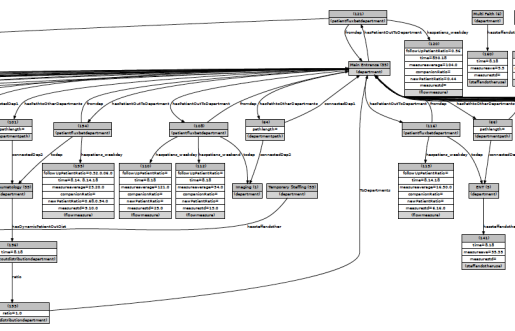The Conclude Consultancy has now completed the first stage of its Occupancy Analytics project for the 3T’s Programme in Brighton for the Brighton & Sussex University Hospitals Trust. Professor Bacon and his team has developed this radical new approach to briefing for complex facilities. The approach is founded in a Facility Activity Model that models all key processes and activities associated with them. The Facility Activity Model is managed in an on-line database. The processes and data for the model was collected and analysed by the BSUH Trust’s analysts. Professor Bacon and his team created what is in effect an open source solution, enabling this data to be re-used for different stages of the hospital development process.

In the illustration above the relationships for each facility function are identified. These relationships are dynamically constructed from the database, processed by the logic that defines the patient pathways and clinical processes.
Using this data the team is also able to forecast occupancy anywhere in the facility and this in turn informs the engineering design. This new science developed by Professor Bacon and his team in the United States, also enables the design of the mechanical engineering systems to be optimised by ensuring that the system design and specifications are founded on a comprehensive understanding of how the facility will perform In-Use.
The illustration above shows the peaks of occupancy in a major circulation space though different times of the day. The forecast is based on a comprehensive understanding of the patient pathways and clinical processes. The data from these studies is now to be processed in what Professor Bacon refers to as a ‘Whole Facility Energy Model’. It is this model that will correlate operational processes with carbon performance. It means that for the first time users will be able to understand the carbon impact of operational decisions.
“This is the first time that this approach to modelling occupancy and energy in-use has been applied to healthcare facilities in the UK. It has been a source of bemusement to me for some years that we do not make more use of the tools available to ensure that we are creating optimised environments for patient care. Teaching hospitals are large, complex organisations and this work is giving us an opportunity to simulate the building in use. In the current financial climate, the Trust must ensure that it is delivering the optimum solution for the pressing need to develop the hospital and thereby create optimum value for the public purse.
We have much more to do but I believe the approach that we are taking as a team will provide future healthcare planners with new tools and knowledge to create better facilities based on modelling and evidence rather than theory and supposition based on what we have done in the past.”
Professor Duane Passman, 3T’s Programme Director
For more information about this exciting innovation, please contact Professor Bacon.


Follow us
on Twitter